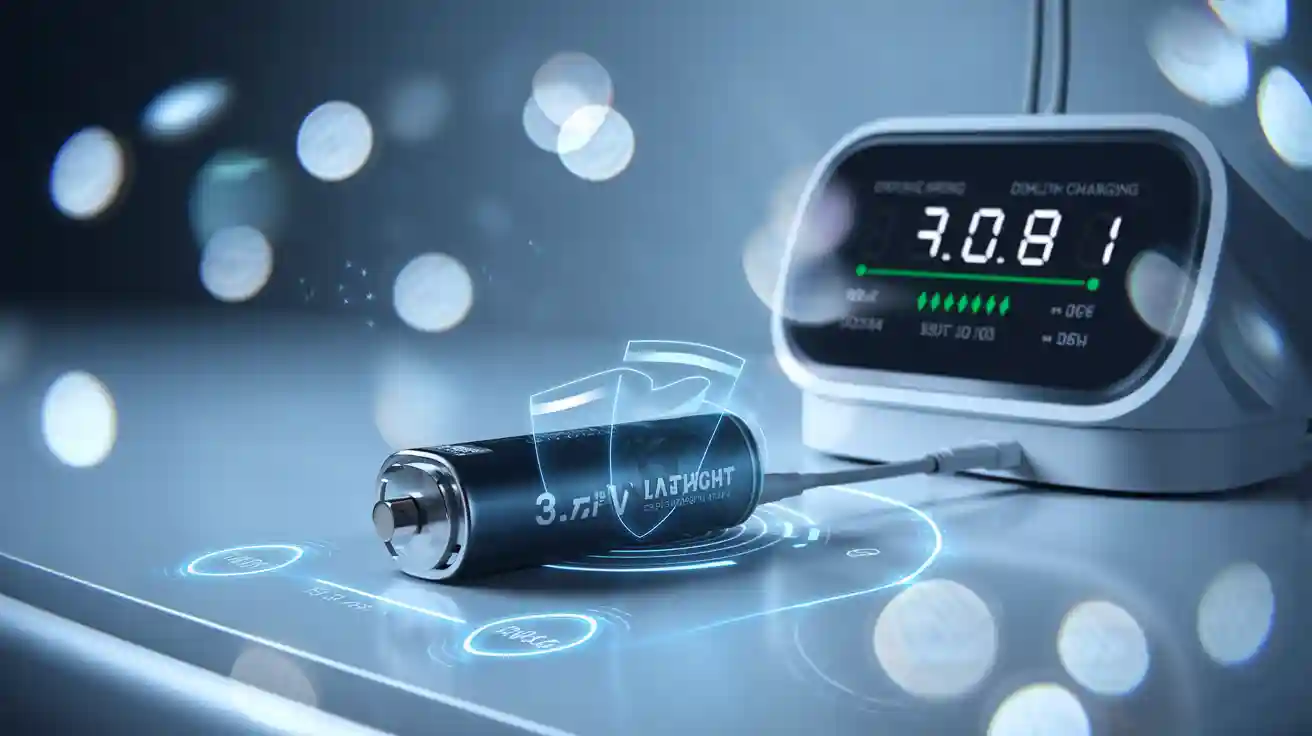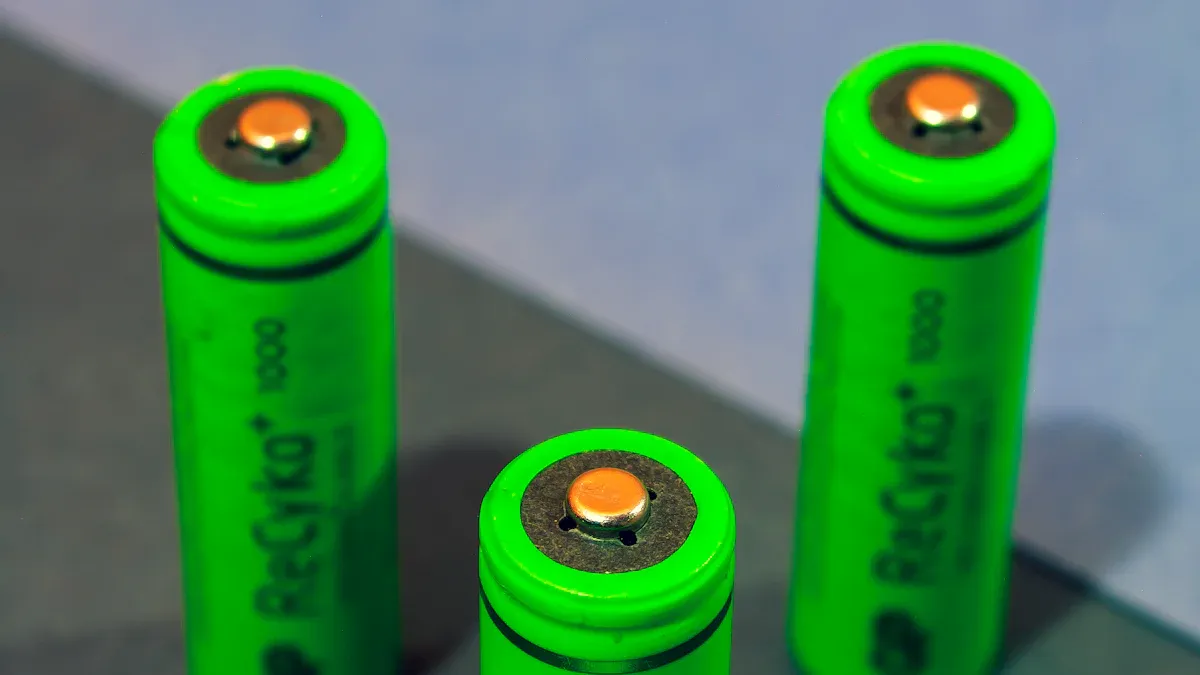
Smart charging gives you the best way to maximize lifespan and battery life for your 3.7V lithium battery. Many users make mistakes that harm battery life. For example, you might fully discharge lithium batteries before charging, but partial charging keeps battery life strong. Using the wrong charger or charging at the wrong rate can overheat the battery and reduce its lifespan. Extreme temperatures also damage lithium batteries and lower battery life expectancy. Always watch for swelling, leaks, or overheating, which signal battery life problems. If you treat all batteries the same, you risk shortening battery life. By following the right charging habits, you keep your lithium battery safe and extend its life.
Maximize Lifespan Tips
Charging Habits
You can maximize lifespan and battery life for your 3.7v lithium-ion cell by building smart charging habits. Always keep your battery charge between 20% and 80%. This range helps you avoid stress on the battery and supports battery longevity. Scientific studies show that charging lithium-ion batteries within this range reduces energy losses. When you charge above 80%, the battery faces higher energy loss and does not gain extra life or performance. Charging below 20% can also harm the battery and shorten its cycle life.
Conseil : Recharge your 3.7v lithium-ion cell before it drops below 20%. Unplug the charger once it reaches 80%. This simple habit will prolong battery life and help you get the most out of your lithium battery.
You should avoid letting your battery sit at 100% for long periods. This habit can cause the battery to age faster. If you use your device daily, try to top up the charge more often instead of waiting for a full discharge. This approach keeps your battery healthy and extends the lifespan of your 3.7v lithium-ion cell.
Éviter la surcharge
Overcharging is one of the main reasons batteries lose capacity and fail early. When you overcharge a lithium-ion battery, you force extra energy into the cell. This process pushes the battery into a saturated state and speeds up degradation. Une surcharge peut entraîner:
- Loss of lithium inventory and active material in the battery.
- Heat and gas production, which increase safety risks.
- Lithium deposits on the anode, which can form dangerous dendrites.
- Structural collapse of the cathode, leading to heat and oxygen release.
- Irreversible capacity loss, even with slight overcharging cycles.
Modern devices use Battery Management Systems (BMS) to prevent overcharging. The BMS monitors voltage, current, temperature, and state of charge. It stops charging when the battery reaches its safe limit. The BMS also balances the charge across all cells in your 3.7v lithium-ion cell pack. This system protects your battery from damage and helps prolong battery life.
Remarque : Even with a BMS, you should unplug your device after it reaches 80% to maximize lifespan. Do not rely only on the system. Your habits play a big role in battery longevity.
Partial Discharges
Partial discharges mean you use only part of your battery’s charge before recharging. This method is better for lithium-ion batteries than full discharges. When you let your battery drop to 0% before charging, you stress the battery and reduce its cycle life. Partial discharges keep the battery in a safe range and help extend the lifespan of your 3.7v lithium-ion cell.
Frequent top-ups are good for lithium-based batteries. You can plug in your device for short periods during the day. This habit keeps the battery within the 20-80% range and avoids deep discharges. It also helps you avoid undercharging, which can happen if you let the battery sit at a low charge for too long.
| Charging Practice | Effect on Battery Life | Recommandation |
|---|---|---|
| Full Discharge | Shortens cycle life | Avoid |
| Surcharge | Causes rapid degradation | Avoid |
| Partial Discharge | Prolongs battery life | Practice regularly |
| Frequent Top-Ups | Supports battery longevity | Practice regularly |
| Sous-charge | Can harm lithium battery | Avoid |
Keeping your 3.7v lithium-ion cell in the 20-80% range, avoiding overcharging, and using partial discharges will help you maximize lifespan, prolong battery life, and get the best performance from your lithium battery.
3.7V Lithium-Ion Cell Care

Use the Right Charger
You should always use the charger recommended by the manufacturer for your 3.7v lithium-ion cell. The right charger matches the battery’s chemistry, voltage, and current needs. Using the wrong charger can damage the battery, reduce its lifespan, and create safety risks. For example, a charger designed for a 3.7v lithium-ion cell will have the correct output voltage and current, built-in protections, and certifications for safety.
| Aspect | Détails |
|---|---|
| Type de batterie | Rechargeable RCR123A Lithium-ion, 3.7V nominal voltage |
| Capacité de la batterie | 750mAh |
| Built-in Protections | Over-charge, over-discharge, short-circuit, overcurrent |
| Charger Output | DC 4.2V / 400mA per channel |
| Temps de charge | 2.5 hours for 750mAh battery |
| Compatibilité | Designed for specific 3.7v lithium-ion cell batteries |
| Safety Warnings | Misuse may cause explosion or fire |
| Certification | UL, IEC, UN, Battery Directive, CSTCG |
| Charger Features | Individual charging channels, LCD status display |
If you use an incorrect charger, you risk overcharging, undercharging, or overheating the battery. These problems can cause fires, shorten battery lifespan, and harm your device. Always follow battery care guidelines and use the original charger for your 3.7v lithium-ion cell.
Set Correct Float Voltage
Setting the right float voltage is key for battery maintenance. For a 3.7v lithium-ion cell, you should set the float voltage between 3.4V and 3.6V per cell. This range keeps the battery healthy and extends its lifespan. If you set the float voltage too high, the battery degrades faster and may become unsafe. If you set it too low, you lose some capacity but gain more cycles and longer lithium battery lifespan.
Conseil : Floating your 3.7v lithium-ion cell at about 3.8V (60% state of charge) can greatly improve longevity. Avoid floating above 4.2V, as this accelerates battery aging and can be dangerous.
Monitor Battery Health
You should check your 3.7v lithium-ion cell regularly to keep track of battery health. Look for signs like reduced capacity, longer charging times, or sudden drops in battery level. Use a multimeter to check voltage. Healthy batteries show 3.7V to 4.2V after charging. If you see swelling, leaks, or overheating, stop using the battery right away.
- Check battery charge status and run time often.
- Replace the battery if it lasts less than 80% of its original time.
- Use battery indicators or monitoring software for better battery care.
- Store batteries at about 50% charge for long-term battery maintenance.
- Avoid deep discharges below 25% to protect your 3.7v lithium-ion cell.
Good battery maintenance and regular checks help you spot problems early and keep your lithium-ion battery safe and reliable.
Battery Storage & Environment

Store at 50% Charge
You can protect battery life and longevity by storing your lithium battery at about 50% charge. When you store batteries fully charged, they lose capacity faster and self-discharge more quickly. Batteries at high charge levels can lose up to 10% of their charge in a month. This happens because the lithium-rich state inside the battery promotes unwanted chemical reactions. If you store batteries at a moderate charge, between 30% and 80%, you help keep battery life stable and reduce self-discharge to less than 0.5%. Charging your lithium battery to only 90-95% before storage also helps prevent capacity loss and supports battery longevity. Always check that the voltage stays below 3.6V during storage for the best cycle life.
Tip: Store your batteries at 50% charge in a cool, dry place to maximize battery life and cycle life.
Avoid Extreme Temperatures
Temperature has a big impact on battery life and cycle life. You should always store your lithium battery between -4°F and 77°F. Storing batteries above 77°F speeds up aging and reduces battery longevity. If you store batteries below -4°F, you risk permanent damage and loss of battery life. High temperatures cause faster chemical reactions inside the battery, which leads to faster degradation and shorter cycle life. Low temperatures slow down the battery’s chemical processes, increase resistance, and can cause dangerous lithium plating. Both extremes harm battery life and reduce the number of cycles your battery can handle.
- Use insulated or climate-controlled storage to keep batteries safe.
- Avoid direct sunlight and sudden temperature changes.
- Keep batteries away from heaters, windows, and cold drafts.
Long-Term Storage Tips
Proper storage is key for battery life and longevity. The best temperature for long-term storage is around 50°F. You should keep humidity near 50% to prevent corrosion and short circuits. Store batteries in a dry, well-ventilated area. Use non-conductive or fireproof containers for extra safety. Recharge your lithium battery every three months to maintain battery life and cycle life. Do not leave batteries connected to chargers for long periods. Always inspect batteries for swelling or leaks before use.
| Aspect | Pratique recommandée |
|---|---|
| Charge Level | Store at 40-60%; recharge every 3 months |
| Température | Keep between 50°F and 86°F; avoid extremes |
| Humidité | Maintain about 50% in a dry environment |
| Storage Container | Use fireproof, non-conductive containers |
| Inspection | Check every 3 months; look for damage |
Note: High humidity can cause corrosion and speed up battery aging. Always store batteries in their original packaging or sealed containers to protect battery life and cycle life.
Extend Lithium Battery Lifespan
Lower Discharge Rate
You can prolong battery life and improve battery performance by lowering the discharge rate of your 3.7v lithium-ion cell. When you use your device at a high discharge rate, the lithium-ion battery heats up and loses capacity faster. Lower discharge rates reduce stress on the battery and help you get more cycles before the battery life drops to half. The table below shows how discharge rate affects cycle life:
| Taux de décharge (C) | Cycle Life (cycles until 50% capacity) | Notes |
|---|---|---|
| 1C | Longer than 450 | Lower stress, longer cycle life |
| 2C | ~450 | Higher stress, reduced cycle life |
Power cells can handle higher discharge rates better than energy cells, but all lithium-ion batteries benefit from moderate, steady use. You can prolong battery life by avoiding heavy loads and keeping your 3.7v lithium-ion cell cool. Oversizing your battery pack also helps reduce stress and extends cycle life.
To reduce the discharge rate in daily use, follow these steps:
- Keep your 3.7v lithium-ion cell entre 20% et 80% charge.
- Use only the charger recommended by the manufacturer.
- Lower screen brightness and close unused apps.
- Turn off Bluetooth and Wi-Fi when not needed.
- Store and use your device in moderate temperatures.
- Activate battery-saving modes.
- Calibrate your battery every few months.
- Monitor battery health with device tools.
- Replace the battery with a certified one if it no longer holds charge.
These habits support battery maintenance, prolong battery life, and improve battery performance.
Update Device Software
You can extend the lifespan of your 3.7v lithium-ion cell by keeping your device software up to date. Manufacturers often release updates that improve battery performance and battery life. Updated software can optimize how your device uses power, manage background tasks, and adjust charging patterns. These improvements help your lithium-ion battery last longer and maintain good cycle life.
Tip: Always check for software updates and install them as soon as they become available. Updated software can fix bugs that drain your battery and add new features to help you manage battery care.
Battery maintenance also depends on smart software. Many devices now include battery health tools that track battery performance and suggest ways to prolong battery life. Use these tools to monitor your 3.7v lithium-ion cell and make changes that support battery longevity.
Recognize Aging Signs
You should watch for signs that your lithium-ion battery is aging. Common signs include reduced battery life, longer charging times, and sudden drops in charge level. If you notice these problems, take action to protect your 3.7v lithium-ion cell and prolong battery life.
- Avoid keeping your lithium-ion battery fully charged for long periods.
- Delay charging until later in the day to reduce time at high charge.
- Limit maximum charge to about 50% for devices like laptops.
- Charge only when the battery is low for items like e-bikes or power tools.
- Do not charge in freezing conditions.
- Limit fast charging, as it increases temperature and speeds up aging.
- Use battery analytics and management systems to optimize charging.
High charging power and fast charging raise battery temperature, which accelerates aging and reduces cycle life. Over time, the lithium-ion battery develops internal changes, such as cracks in the anode and collapse of cathode materials. These changes increase resistance and lower battery performance. By recognizing these signs early, you can adjust your habits and prolong battery life.
Note: Always operate your 3.7v lithium-ion cell within the temperature and charging limits set by the supplier. Smart battery care and regular maintenance will help you extend the lifespan of your battery and keep your device running at its best.
You can maximize battery life and lifespan by following smart charging and care practices. Always keep your battery between 20% and 80% charge. Store your battery at 50% in a cool, dry place. Use the correct charger and avoid overcharging. Regularly update your device for better battery performance. Industry tests show that smart charging lowers costs and extends battery life. Consistent habits like partial charging, proper storage, and careful use help you get the best battery performance and longer battery life. Start these steps today for reliable battery life and top performance.
Remember: Good battery care means longer battery life, better performance, and less waste. Your battery will thank you!
- Avoid deep discharges and overcharging to protect battery life.
- Store your battery at the right temperature for best battery life.
- Use the right charger to keep battery life strong.
- Monitor battery health for top battery performance.
- Limit fast charging to improve battery life.
FAQ
How often should you charge your 3.7V lithium battery?
You should charge your battery when it drops to about 20%. Try to unplug it when it reaches 80%. This habit helps your battery last longer and keeps it working well.
Can you leave your device plugged in overnight?
It is best not to leave your device plugged in overnight. Charging for too long can heat up the battery and speed up aging. Unplug your device once it reaches the right charge level.
What happens if your battery gets too hot?
High temperatures can damage your battery. Heat speeds up chemical reactions inside the cell. This can cause swelling, leaks, or even fires. Always keep your battery cool and away from direct sunlight.
How do you know when to replace your lithium battery?
- Your battery drains quickly.
- Charging takes much longer than before.
- The battery feels hot or looks swollen.
If you notice these signs, you should replace your battery soon.
Is it safe to use any charger with your 3.7V lithium battery?
You should only use the charger recommended by the manufacturer. Using the wrong charger can damage your battery, lower its lifespan, or cause safety problems.

